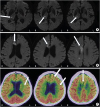2. Mariën P, Engelborghs S, Vignolo LA, De Deyn PP. The many faces of crossed aphasia in dextrals: report of nine cases and review of the literature. Eur J Neurol. 2001; 8:643–658.


3. Ivanova MV, Isaev DY, Dragoy OV, Akinina YS, Petrushevskiy AG, Fedina ON, Shklovsky VM, Dronkers NF. Diffusion-tensor imaging of major white matter tracts and their role in language processing in aphasia. Cortex. 2016; 85:165–181.


4. Saba S, Blum S. Aphasia due to isolated infarction of the corpus callosum. BMJ Case Rep. 2014; 2014:bcr2014204316.

5. Li S, Sun X, Bai YM, Qin HM, Wu XM, Zhang X, Jolkkonen J, Boltze J, Wang SP. Infarction of the corpus callosum: a retrospective clinical investigation. PLoS One. 2015; 10:e0120409.

6. Ishizaki M, Ueyama H, Nishida Y, Imamura S, Hirano T, Uchino M. Crossed aphasia following an infarction in the right corpus callosum. Clin Neurol Neurosurg. 2012; 114:161–165.


8. Yang LL, Huang YN, Cui ZT. Clinical features of acute corpus callosum infarction patients. Int J Clin Exp Pathol. 2014; 7:5160–5164.


9. Tsumoto T, Nishioka K, Nakakita K, Hayashi S, Maeshima S. Acquired stuttering associated with callosal infarction: a case report. No Shinkei Geka. 1999; 27:79–83.

10. Chung SJ, Kim JH, Ahn HJ, Han ZA, Cho JH, Kim GS, Choi SA, Lee JH. Callosal dysarthria. Clin Neurol Neurosurg. 2013; 115:1173–1176.


11. Bhatnagar SC, Buckingham HW, Puglisi-Creegan S, Hacein-Bey L. Crossed aphasia in a patient with congenital lesion in the right hemisphere. Aphasiology. 2011; 25:27–42.

12. Jones AB, Bak TH, Bastin ME, Wardlaw JM, Pernet CR. Does crossed aphasia originate from developmental disorders? A Mini-review and case study. bioRxiv. 2016.

13. Alexander MP, Annett M. Crossed aphasia and related anomalies of cerebral organization: case reports and a genetic hypothesis. Brain Lang. 1996; 55:213–239.


14. Finger S, Koehler PJ, Jagella C. The Monakow concept of diaschisis: origins and perspectives. Arch Neurol. 2004; 61:283–288.

15. Perani D, Papagno C, Cappa S, Gerundini P, Fazio F. Crossed aphasia: functional studies with single photon emission computerized tomography. Cortex. 1988; 24:171–178.


16. Bakar M, Kirshner HS, Wertz RT. Crossed aphasia. Functional brain imaging with PET or SPECT. Arch Neurol. 1996; 53:1026–1032.







 PDF
PDF Citation
Citation Print
Print



 XML Download
XML Download